Ulcerative Colitis: Eleanor's Case Study, Symptoms, and Treatment
VerifiedAdded on 2023/04/12
|6
|1312
|160
Report
AI Summary
This report presents a comprehensive analysis of ulcerative colitis, focusing on a specific case study. It explores the structural and functional changes associated with the disease, explaining how these changes lead to symptoms like weight loss and abdominal pain. The report also examines the pain pathways involved and how morphine is used to manage pain, discussing its mechanism of action and limitations. Furthermore, it details the clinical manifestations indicating a deterioration of the condition, including specific signs and symptoms observed in the patient. Finally, the report analyzes the characteristics and rationale behind the intravenous fluid (Hartman’s solution) prescribed, relating it to the patient's fluid balance and overall condition. The report uses references to support the findings.
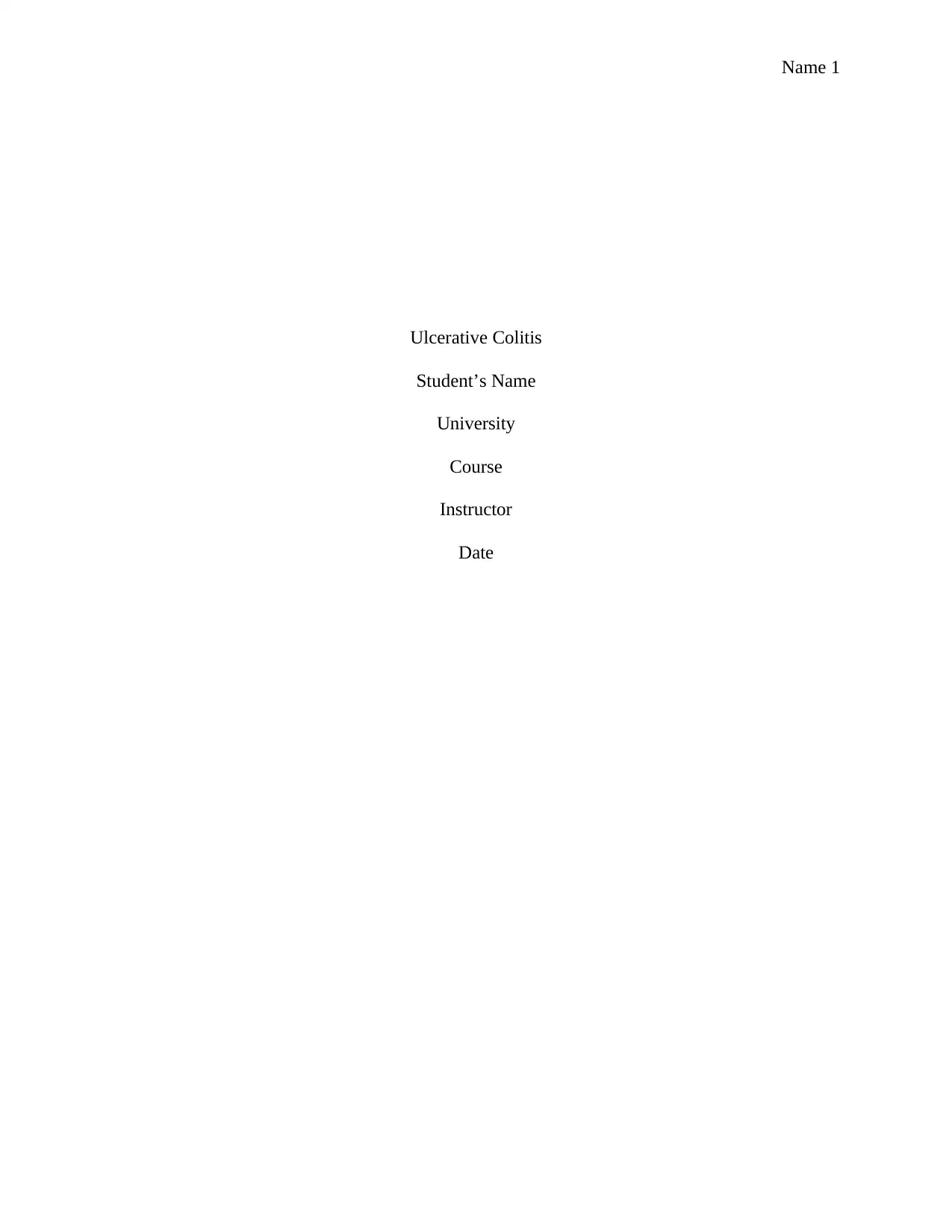
Name 1
Ulcerative Colitis
Student’s Name
University
Course
Instructor
Date
Ulcerative Colitis
Student’s Name
University
Course
Instructor
Date
Paraphrase This Document
Need a fresh take? Get an instant paraphrase of this document with our AI Paraphraser
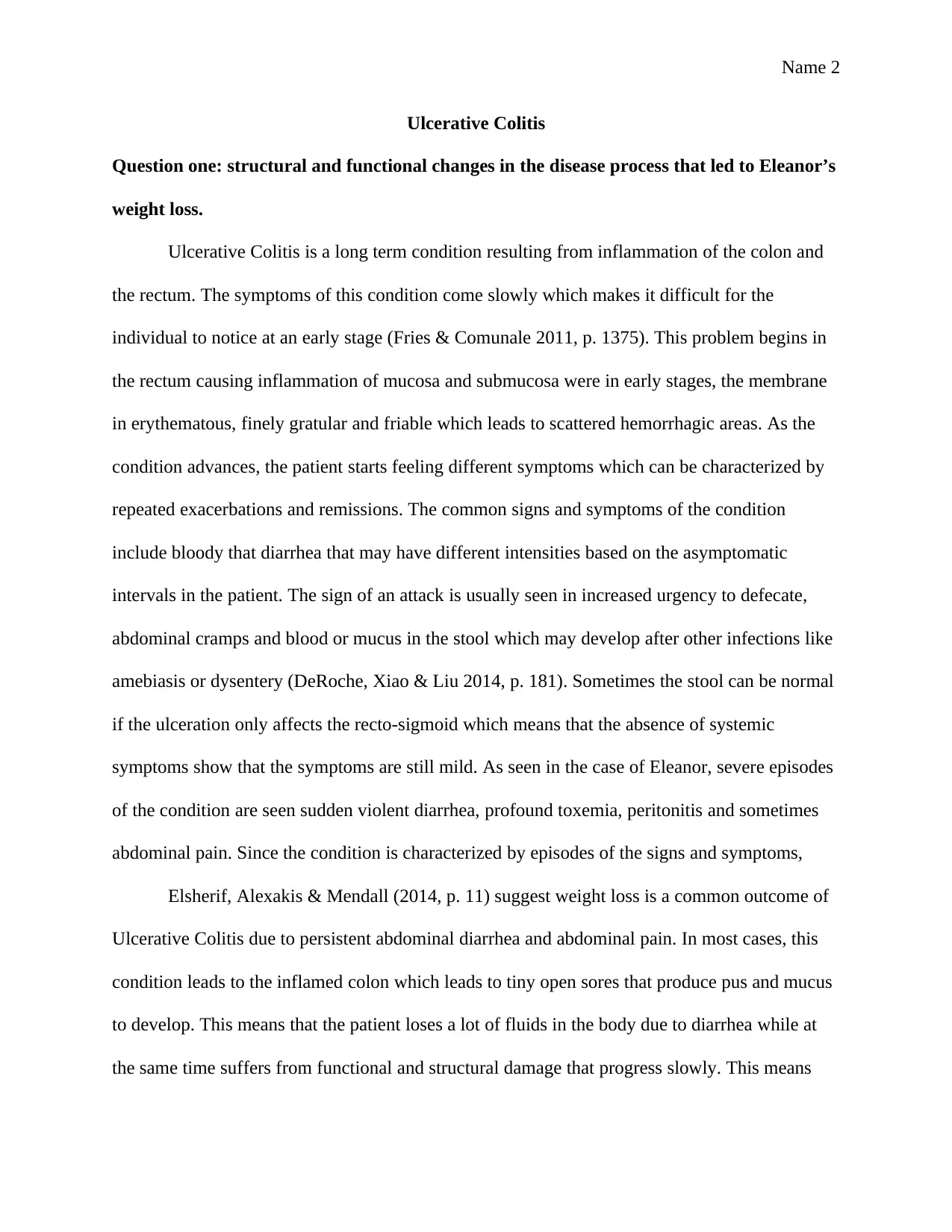
Name 2
Ulcerative Colitis
Question one: structural and functional changes in the disease process that led to Eleanor’s
weight loss.
Ulcerative Colitis is a long term condition resulting from inflammation of the colon and
the rectum. The symptoms of this condition come slowly which makes it difficult for the
individual to notice at an early stage (Fries & Comunale 2011, p. 1375). This problem begins in
the rectum causing inflammation of mucosa and submucosa were in early stages, the membrane
in erythematous, finely gratular and friable which leads to scattered hemorrhagic areas. As the
condition advances, the patient starts feeling different symptoms which can be characterized by
repeated exacerbations and remissions. The common signs and symptoms of the condition
include bloody that diarrhea that may have different intensities based on the asymptomatic
intervals in the patient. The sign of an attack is usually seen in increased urgency to defecate,
abdominal cramps and blood or mucus in the stool which may develop after other infections like
amebiasis or dysentery (DeRoche, Xiao & Liu 2014, p. 181). Sometimes the stool can be normal
if the ulceration only affects the recto-sigmoid which means that the absence of systemic
symptoms show that the symptoms are still mild. As seen in the case of Eleanor, severe episodes
of the condition are seen sudden violent diarrhea, profound toxemia, peritonitis and sometimes
abdominal pain. Since the condition is characterized by episodes of the signs and symptoms,
Elsherif, Alexakis & Mendall (2014, p. 11) suggest weight loss is a common outcome of
Ulcerative Colitis due to persistent abdominal diarrhea and abdominal pain. In most cases, this
condition leads to the inflamed colon which leads to tiny open sores that produce pus and mucus
to develop. This means that the patient loses a lot of fluids in the body due to diarrhea while at
the same time suffers from functional and structural damage that progress slowly. This means
Ulcerative Colitis
Question one: structural and functional changes in the disease process that led to Eleanor’s
weight loss.
Ulcerative Colitis is a long term condition resulting from inflammation of the colon and
the rectum. The symptoms of this condition come slowly which makes it difficult for the
individual to notice at an early stage (Fries & Comunale 2011, p. 1375). This problem begins in
the rectum causing inflammation of mucosa and submucosa were in early stages, the membrane
in erythematous, finely gratular and friable which leads to scattered hemorrhagic areas. As the
condition advances, the patient starts feeling different symptoms which can be characterized by
repeated exacerbations and remissions. The common signs and symptoms of the condition
include bloody that diarrhea that may have different intensities based on the asymptomatic
intervals in the patient. The sign of an attack is usually seen in increased urgency to defecate,
abdominal cramps and blood or mucus in the stool which may develop after other infections like
amebiasis or dysentery (DeRoche, Xiao & Liu 2014, p. 181). Sometimes the stool can be normal
if the ulceration only affects the recto-sigmoid which means that the absence of systemic
symptoms show that the symptoms are still mild. As seen in the case of Eleanor, severe episodes
of the condition are seen sudden violent diarrhea, profound toxemia, peritonitis and sometimes
abdominal pain. Since the condition is characterized by episodes of the signs and symptoms,
Elsherif, Alexakis & Mendall (2014, p. 11) suggest weight loss is a common outcome of
Ulcerative Colitis due to persistent abdominal diarrhea and abdominal pain. In most cases, this
condition leads to the inflamed colon which leads to tiny open sores that produce pus and mucus
to develop. This means that the patient loses a lot of fluids in the body due to diarrhea while at
the same time suffers from functional and structural damage that progress slowly. This means
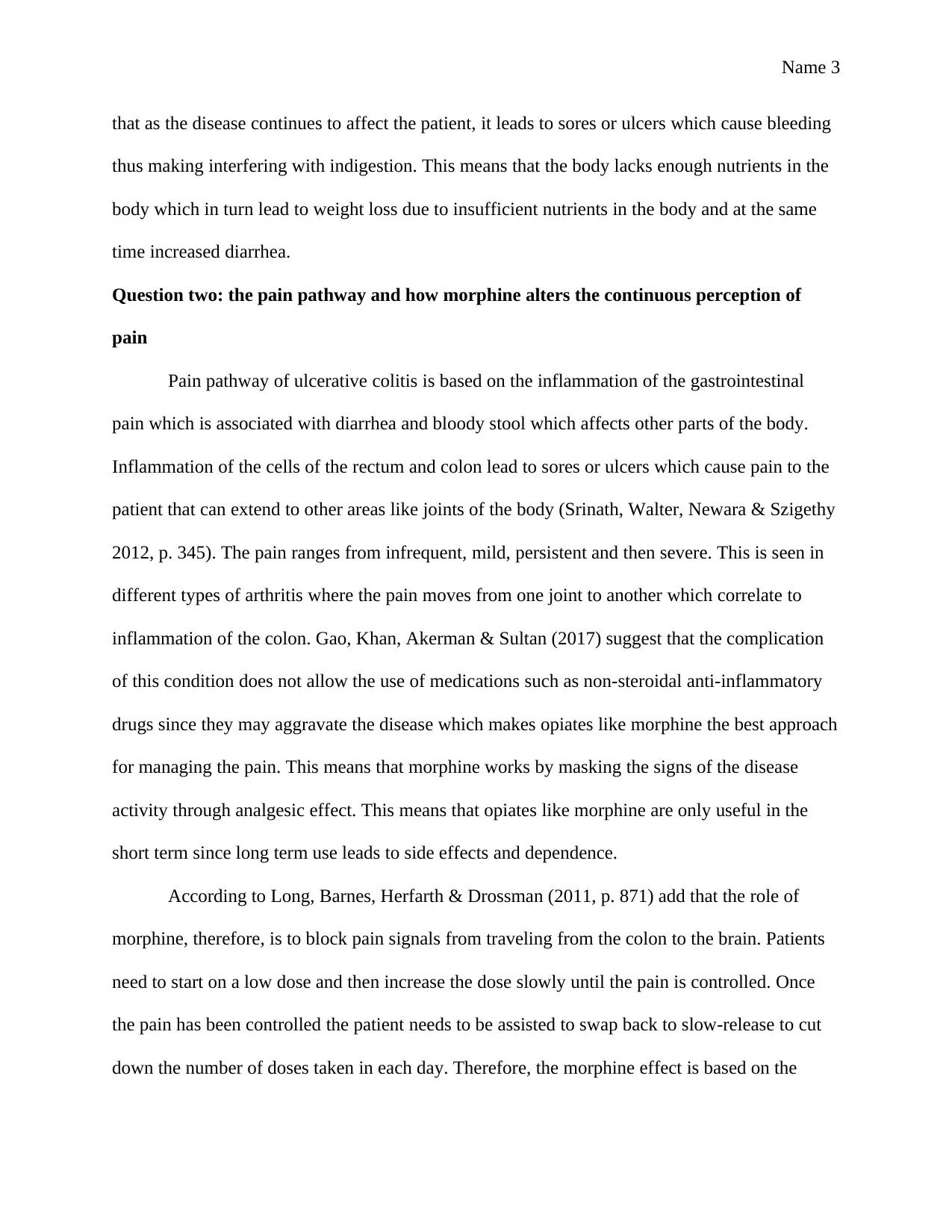
Name 3
that as the disease continues to affect the patient, it leads to sores or ulcers which cause bleeding
thus making interfering with indigestion. This means that the body lacks enough nutrients in the
body which in turn lead to weight loss due to insufficient nutrients in the body and at the same
time increased diarrhea.
Question two: the pain pathway and how morphine alters the continuous perception of
pain
Pain pathway of ulcerative colitis is based on the inflammation of the gastrointestinal
pain which is associated with diarrhea and bloody stool which affects other parts of the body.
Inflammation of the cells of the rectum and colon lead to sores or ulcers which cause pain to the
patient that can extend to other areas like joints of the body (Srinath, Walter, Newara & Szigethy
2012, p. 345). The pain ranges from infrequent, mild, persistent and then severe. This is seen in
different types of arthritis where the pain moves from one joint to another which correlate to
inflammation of the colon. Gao, Khan, Akerman & Sultan (2017) suggest that the complication
of this condition does not allow the use of medications such as non-steroidal anti-inflammatory
drugs since they may aggravate the disease which makes opiates like morphine the best approach
for managing the pain. This means that morphine works by masking the signs of the disease
activity through analgesic effect. This means that opiates like morphine are only useful in the
short term since long term use leads to side effects and dependence.
According to Long, Barnes, Herfarth & Drossman (2011, p. 871) add that the role of
morphine, therefore, is to block pain signals from traveling from the colon to the brain. Patients
need to start on a low dose and then increase the dose slowly until the pain is controlled. Once
the pain has been controlled the patient needs to be assisted to swap back to slow-release to cut
down the number of doses taken in each day. Therefore, the morphine effect is based on the
that as the disease continues to affect the patient, it leads to sores or ulcers which cause bleeding
thus making interfering with indigestion. This means that the body lacks enough nutrients in the
body which in turn lead to weight loss due to insufficient nutrients in the body and at the same
time increased diarrhea.
Question two: the pain pathway and how morphine alters the continuous perception of
pain
Pain pathway of ulcerative colitis is based on the inflammation of the gastrointestinal
pain which is associated with diarrhea and bloody stool which affects other parts of the body.
Inflammation of the cells of the rectum and colon lead to sores or ulcers which cause pain to the
patient that can extend to other areas like joints of the body (Srinath, Walter, Newara & Szigethy
2012, p. 345). The pain ranges from infrequent, mild, persistent and then severe. This is seen in
different types of arthritis where the pain moves from one joint to another which correlate to
inflammation of the colon. Gao, Khan, Akerman & Sultan (2017) suggest that the complication
of this condition does not allow the use of medications such as non-steroidal anti-inflammatory
drugs since they may aggravate the disease which makes opiates like morphine the best approach
for managing the pain. This means that morphine works by masking the signs of the disease
activity through analgesic effect. This means that opiates like morphine are only useful in the
short term since long term use leads to side effects and dependence.
According to Long, Barnes, Herfarth & Drossman (2011, p. 871) add that the role of
morphine, therefore, is to block pain signals from traveling from the colon to the brain. Patients
need to start on a low dose and then increase the dose slowly until the pain is controlled. Once
the pain has been controlled the patient needs to be assisted to swap back to slow-release to cut
down the number of doses taken in each day. Therefore, the morphine effect is based on the
⊘ This is a preview!⊘
Do you want full access?
Subscribe today to unlock all pages.

Trusted by 1+ million students worldwide
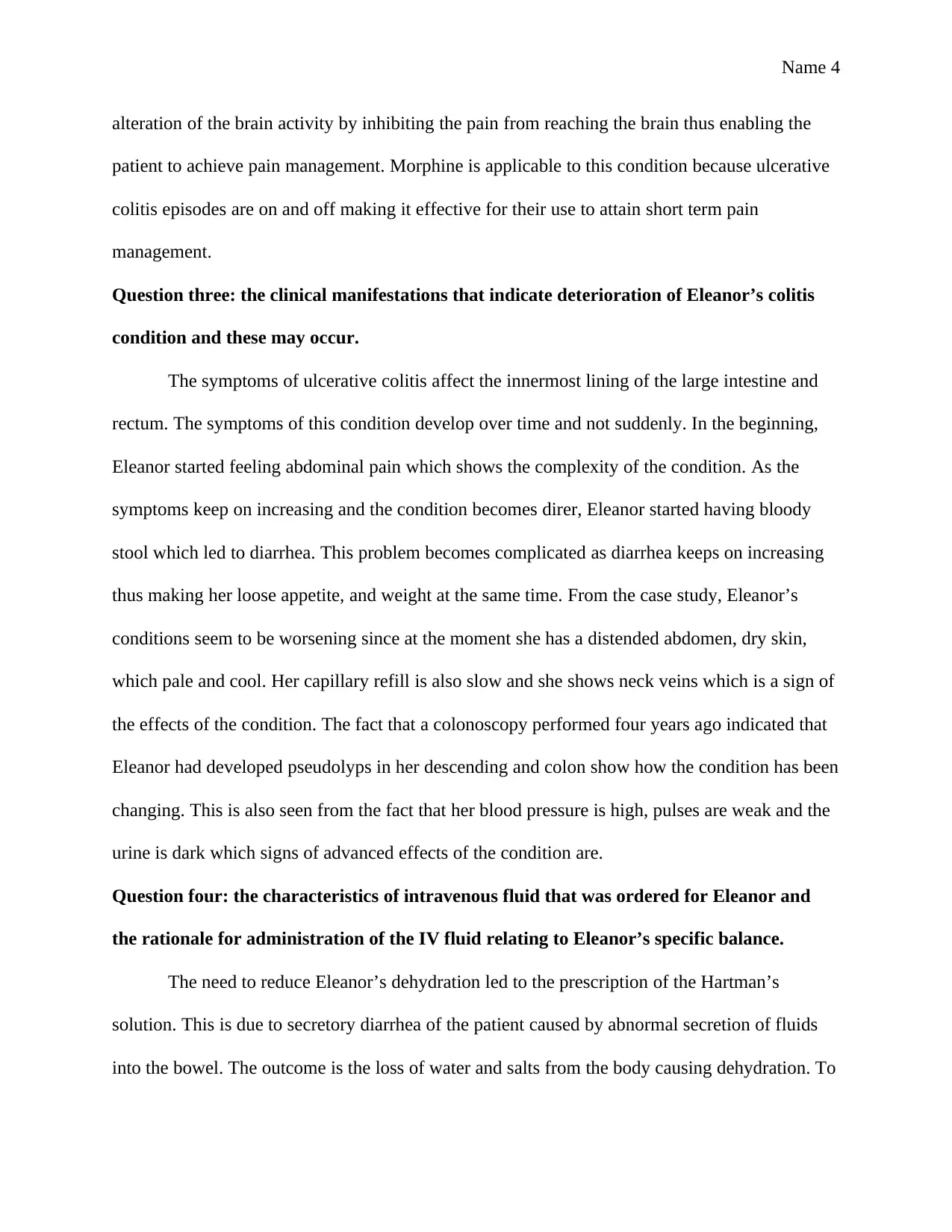
Name 4
alteration of the brain activity by inhibiting the pain from reaching the brain thus enabling the
patient to achieve pain management. Morphine is applicable to this condition because ulcerative
colitis episodes are on and off making it effective for their use to attain short term pain
management.
Question three: the clinical manifestations that indicate deterioration of Eleanor’s colitis
condition and these may occur.
The symptoms of ulcerative colitis affect the innermost lining of the large intestine and
rectum. The symptoms of this condition develop over time and not suddenly. In the beginning,
Eleanor started feeling abdominal pain which shows the complexity of the condition. As the
symptoms keep on increasing and the condition becomes direr, Eleanor started having bloody
stool which led to diarrhea. This problem becomes complicated as diarrhea keeps on increasing
thus making her loose appetite, and weight at the same time. From the case study, Eleanor’s
conditions seem to be worsening since at the moment she has a distended abdomen, dry skin,
which pale and cool. Her capillary refill is also slow and she shows neck veins which is a sign of
the effects of the condition. The fact that a colonoscopy performed four years ago indicated that
Eleanor had developed pseudolyps in her descending and colon show how the condition has been
changing. This is also seen from the fact that her blood pressure is high, pulses are weak and the
urine is dark which signs of advanced effects of the condition are.
Question four: the characteristics of intravenous fluid that was ordered for Eleanor and
the rationale for administration of the IV fluid relating to Eleanor’s specific balance.
The need to reduce Eleanor’s dehydration led to the prescription of the Hartman’s
solution. This is due to secretory diarrhea of the patient caused by abnormal secretion of fluids
into the bowel. The outcome is the loss of water and salts from the body causing dehydration. To
alteration of the brain activity by inhibiting the pain from reaching the brain thus enabling the
patient to achieve pain management. Morphine is applicable to this condition because ulcerative
colitis episodes are on and off making it effective for their use to attain short term pain
management.
Question three: the clinical manifestations that indicate deterioration of Eleanor’s colitis
condition and these may occur.
The symptoms of ulcerative colitis affect the innermost lining of the large intestine and
rectum. The symptoms of this condition develop over time and not suddenly. In the beginning,
Eleanor started feeling abdominal pain which shows the complexity of the condition. As the
symptoms keep on increasing and the condition becomes direr, Eleanor started having bloody
stool which led to diarrhea. This problem becomes complicated as diarrhea keeps on increasing
thus making her loose appetite, and weight at the same time. From the case study, Eleanor’s
conditions seem to be worsening since at the moment she has a distended abdomen, dry skin,
which pale and cool. Her capillary refill is also slow and she shows neck veins which is a sign of
the effects of the condition. The fact that a colonoscopy performed four years ago indicated that
Eleanor had developed pseudolyps in her descending and colon show how the condition has been
changing. This is also seen from the fact that her blood pressure is high, pulses are weak and the
urine is dark which signs of advanced effects of the condition are.
Question four: the characteristics of intravenous fluid that was ordered for Eleanor and
the rationale for administration of the IV fluid relating to Eleanor’s specific balance.
The need to reduce Eleanor’s dehydration led to the prescription of the Hartman’s
solution. This is due to secretory diarrhea of the patient caused by abnormal secretion of fluids
into the bowel. The outcome is the loss of water and salts from the body causing dehydration. To
Paraphrase This Document
Need a fresh take? Get an instant paraphrase of this document with our AI Paraphraser

Name 5
address this dehydration problem, Hoorn (2017, p. 484) suggests that fluid resuscitation is
required Hartman’s solution is used to supply sodium and lactate which is then metabolized to
carbonate to correct the acidosis. This is because the solution has several salts that are used to
create an isotonic solution. Adults are given 30ml/kg within 30 minutes and then 70ml/kg in the
next two and a half hours. This leads to a total of 100ml/kg in three hours. However, the
practitioner needs to calculate the fluid loss and presumed fluid deficit which will help in
determining how the patient will be intravenously given the solution. The outcome is reduced
dehydration of the body since Eleanor has a poor appetite which has reduced eating and fluid
consumption which in turn weakens the body. The role of Harman’s solution is to hydrate the
body and improve the condition of the patient’s body.
address this dehydration problem, Hoorn (2017, p. 484) suggests that fluid resuscitation is
required Hartman’s solution is used to supply sodium and lactate which is then metabolized to
carbonate to correct the acidosis. This is because the solution has several salts that are used to
create an isotonic solution. Adults are given 30ml/kg within 30 minutes and then 70ml/kg in the
next two and a half hours. This leads to a total of 100ml/kg in three hours. However, the
practitioner needs to calculate the fluid loss and presumed fluid deficit which will help in
determining how the patient will be intravenously given the solution. The outcome is reduced
dehydration of the body since Eleanor has a poor appetite which has reduced eating and fluid
consumption which in turn weakens the body. The role of Harman’s solution is to hydrate the
body and improve the condition of the patient’s body.
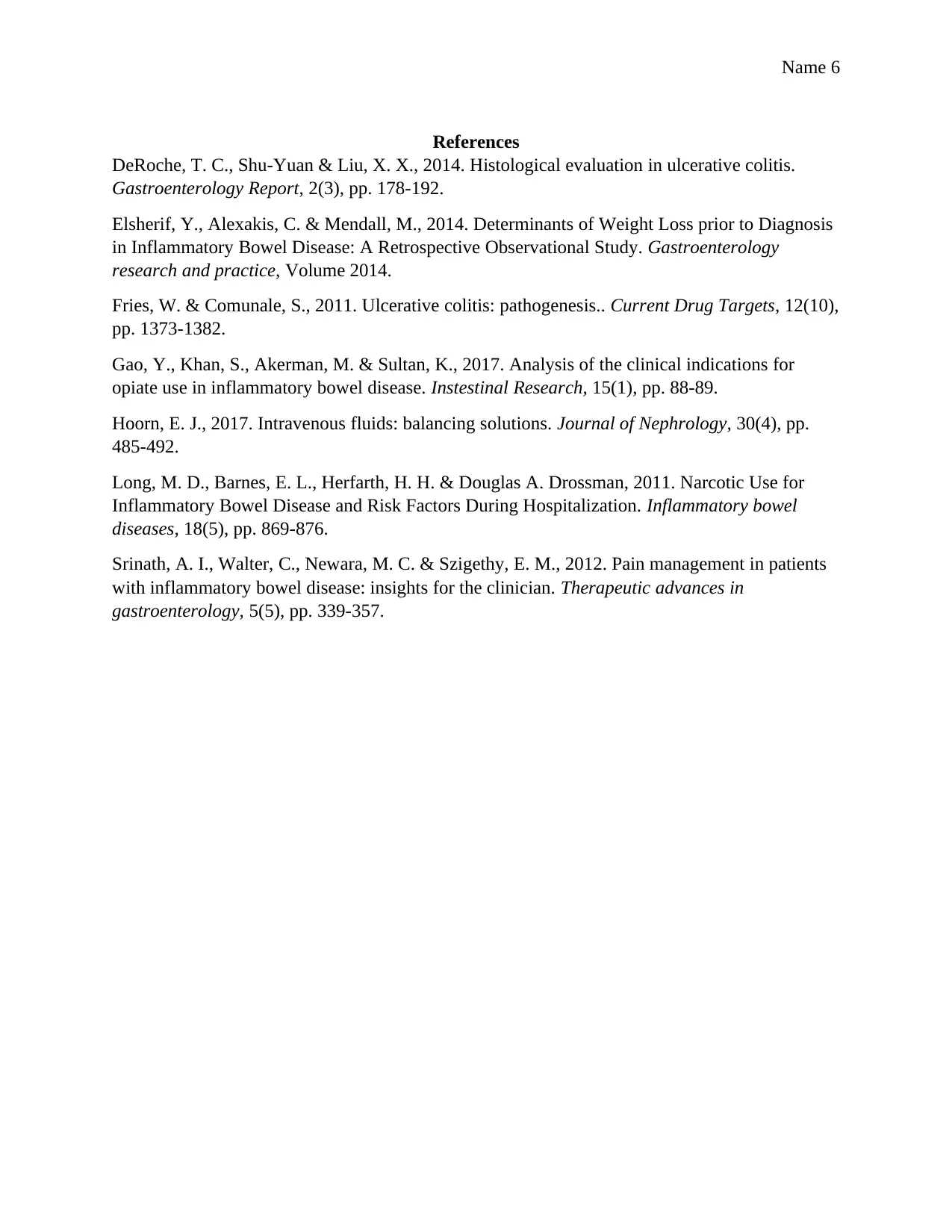
Name 6
References
DeRoche, T. C., Shu-Yuan & Liu, X. X., 2014. Histological evaluation in ulcerative colitis.
Gastroenterology Report, 2(3), pp. 178-192.
Elsherif, Y., Alexakis, C. & Mendall, M., 2014. Determinants of Weight Loss prior to Diagnosis
in Inflammatory Bowel Disease: A Retrospective Observational Study. Gastroenterology
research and practice, Volume 2014.
Fries, W. & Comunale, S., 2011. Ulcerative colitis: pathogenesis.. Current Drug Targets, 12(10),
pp. 1373-1382.
Gao, Y., Khan, S., Akerman, M. & Sultan, K., 2017. Analysis of the clinical indications for
opiate use in inflammatory bowel disease. Instestinal Research, 15(1), pp. 88-89.
Hoorn, E. J., 2017. Intravenous fluids: balancing solutions. Journal of Nephrology, 30(4), pp.
485-492.
Long, M. D., Barnes, E. L., Herfarth, H. H. & Douglas A. Drossman, 2011. Narcotic Use for
Inflammatory Bowel Disease and Risk Factors During Hospitalization. Inflammatory bowel
diseases, 18(5), pp. 869-876.
Srinath, A. I., Walter, C., Newara, M. C. & Szigethy, E. M., 2012. Pain management in patients
with inflammatory bowel disease: insights for the clinician. Therapeutic advances in
gastroenterology, 5(5), pp. 339-357.
References
DeRoche, T. C., Shu-Yuan & Liu, X. X., 2014. Histological evaluation in ulcerative colitis.
Gastroenterology Report, 2(3), pp. 178-192.
Elsherif, Y., Alexakis, C. & Mendall, M., 2014. Determinants of Weight Loss prior to Diagnosis
in Inflammatory Bowel Disease: A Retrospective Observational Study. Gastroenterology
research and practice, Volume 2014.
Fries, W. & Comunale, S., 2011. Ulcerative colitis: pathogenesis.. Current Drug Targets, 12(10),
pp. 1373-1382.
Gao, Y., Khan, S., Akerman, M. & Sultan, K., 2017. Analysis of the clinical indications for
opiate use in inflammatory bowel disease. Instestinal Research, 15(1), pp. 88-89.
Hoorn, E. J., 2017. Intravenous fluids: balancing solutions. Journal of Nephrology, 30(4), pp.
485-492.
Long, M. D., Barnes, E. L., Herfarth, H. H. & Douglas A. Drossman, 2011. Narcotic Use for
Inflammatory Bowel Disease and Risk Factors During Hospitalization. Inflammatory bowel
diseases, 18(5), pp. 869-876.
Srinath, A. I., Walter, C., Newara, M. C. & Szigethy, E. M., 2012. Pain management in patients
with inflammatory bowel disease: insights for the clinician. Therapeutic advances in
gastroenterology, 5(5), pp. 339-357.
⊘ This is a preview!⊘
Do you want full access?
Subscribe today to unlock all pages.

Trusted by 1+ million students worldwide
1 out of 6
Related Documents
Your All-in-One AI-Powered Toolkit for Academic Success.
+13062052269
info@desklib.com
Available 24*7 on WhatsApp / Email
![[object Object]](/_next/static/media/star-bottom.7253800d.svg)
Unlock your academic potential
Copyright © 2020–2025 A2Z Services. All Rights Reserved. Developed and managed by ZUCOL.




